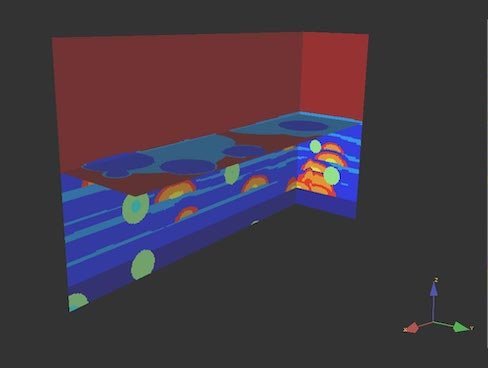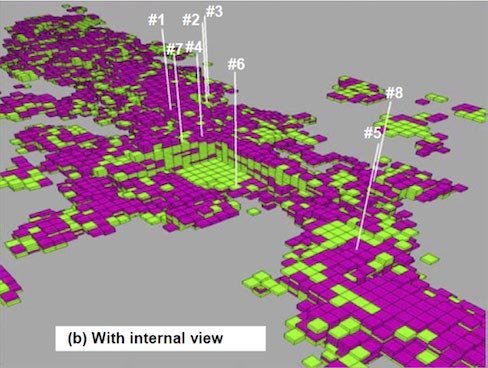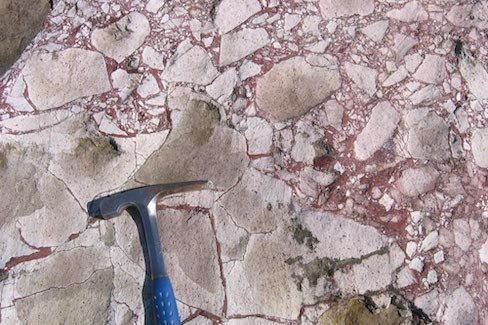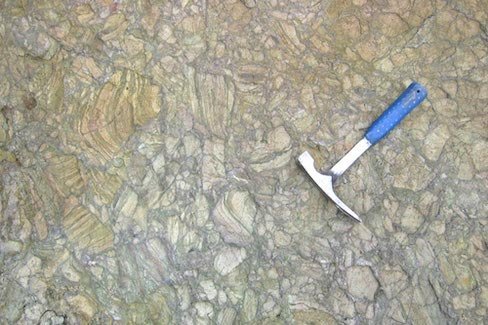Volcanic Rock Reservoir Modeling
Most of the volcanic rock reservoirs in Japan were erupted underwater. Understanding their chemical compositions, structure, and distribution is the most critical to exploration. Volcanic rock reservoirs, as one of the unconventional reservoirs, are expected to contribute to securing reserves in the future.
Geostatistics, a field of applied mathematics that began with the prediction of underground reserves of natural resources, has shown remarkable progress in the 1990s and 2000s. It has become an important method for the analysis of volcanic rock reservoirs.
JAPEX has over 50 years of experience in exploration and development of volcanic rock reservoirs in Japan, applying geostatistics to analyze volcanic rock reservoirs.
Characteristics of Volcanic Rock Reservoirs
From a global perspective, volcanic rocks serve as a lid to keep hydrocarbons, which are the source of oil and natural gas, and are not a major source of hydrocarbon-bearing rocks. However, it has been reported worldwide that volcanic rocks are also used as reservoirs, meaning that the analysis of volcanic rock reservoirs has the potential to discover new hydrocarbons.
In Japan, there are oil and gas fields consisting of subaqueous volcanic rock reservoirs in the Miocene age. Two types of reservoirs are known: felsic rock, which is rich in silica (SiO2) and mafic rock, which is poor in silica. The lithofacies (characteristics of the rocks comprising the geology) of volcanic rocks differs according to the characteristics of each type.
- Felsic rock (SiO2-rich, dacite to rhyolite): Katakai gas field, Yoshii gas field, Niigata Prefecture, etc.
- Mafic rock (SiO2-poor, basalt): Yurihara oil and gas field, Akita Prefecture, etc.
Volcanic Rock Reservoir Modeling Using Geostatistics
JAPEX uses multi-point geostatistics for geological modeling of volcanic rock reservoirs and has confirmed the effectiveness of this method.
Compared to sandstone reservoirs, volcanic rock reservoirs are highly heterogeneous. Therefore, JAPEX has evaluated volcanic rock reservoirs by using geostatistical modeling method (multiple-point statistics) for geological modeling. The geological model integrates the rock morphology of volcanic rock analogs observed at the outcrop, data obtained directly by drilling the volcanic rock reservoir (hard data with high accuracy), and the trends of lithological distribution inferred from the hard data (soft data with relatively low accuracy).
The geological model represents the volcanic deposits (rhyolite and basalt) erupted by subaqueous activity that compose the reservoir and the various volcanic rock facies (lava facies, block lava facies and resedimented facies) that compose the volcanic deposits. The geological model is used for flow simulation and various reservoir evaluations.


Volcanic rock reservoir modeling image (left: training image / right: realization image, source: *1)
(Source)
*1: Tomomi Yamada and Yoshiyuki Okano, 2006, Modeling and flow simulation of a volcanic reservoir: Application of multi-point geostatics and probability perturbation theories to a real field, Jour. Japan. Assoc. Petrol. Tech., 71, 1, 85-93
Geological modeling of volcanic rock reservoirs at the Katakai gas field, Niigata Prefecture
Geostatistics has also been applied to the geological modeling of the SiO2-rich volcanic rock reservoirs at the Katakai gas field in Niigata Prefecture. Based on the results of geological surveys, we have developed a geological conceptual model, which is used to create training images for multi-point geostatistical modeling.
The outer part of the high-temperature felsic volcanic rock that erupted on the seafloor shows water-cooled fracturing that occurred when it came into contact with cold seawater. The block lava facies formed by the fracturing is a good reservoir rock in actual oil and gas fields.


Reservoir lithofacies of volcanic rocks
(left: in-situ block lava facies with jigsaw-fit texture / right: rotated block lava facies)
- Related
Our website uses cookies to improve the convenience of our visitors when browsing our site. If you agree with our policy on the use of cookies, please click the "Agree" button. If you do not agree to the use of cookies when browsing our website, please disable the cookie setting in your browser.
